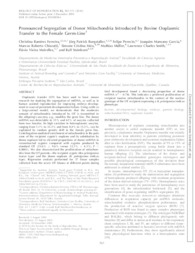Pronounced segregation of donor mitochondria introduced by bovine Ooplasmic tranfer to the female germ-line.
Pronounced segregation of donor mitochondria introduced by bovine Ooplasmic tranfer to the female germ-line.
Author(s): FERREIRA, C. R.; BURGSTALLER, J. P.; PERECIN, F.; GARCIA, J. M.; CHIARATTI, M. R.; MÉO, S. C.; MULLER, M.; SMITH, L. C.; MEIRELLES, F. V.; STEINBORN, R.
Summary: Ooplasmic transfer (01) has been used in basic mouse research for studying lhe segregation of mtDNA, as well as in human assisted reproduction for improving embryo development in cases of persistent developmental failure. Using cattle as a large-animal model, we demonstrate that lhe moderate amount of mitochondria introduced by OT is transmitted to lhe offspring's oocytes; e.g., modifies lhe germ fine. The danar mtDNA was detectable in 25% and 65% of oocytes collected from two females. Its high variation in heteroplasmic oocytes, ranging from 1.1% to 33.5% and from 0.4% to 15.5%, can be explained by random genetic drift in lhe female germ line. Centrifugation-mediated enrichment of mitochondria il1 lhe pole zone of lhe recipient zygote's ooplasm and its substitution by danar ooplasm led to elevated proportions of danar mtDNA in reconstructed zygotes compared with zygotes produced by standard OT (23.6% :!: 9.6% versus 12.1% :!: 4.5%; P <0.0001). We also characterized lhe proliferation of mitochondria from lhe OT parents-the recipient zygote (Bos primigenius taurus type) and lhe danar ooplasm (B. primigenius indicus type). Regression analysis performed for 57 tissue samples collected from lhe seven OT fetuses at different points during fetal development found a decreasing proportion of donor mt DNA (r2=0.78). This indicates a preferred proliferation of recipient of the OT recipeint expressinf a B. primigenius indicus phenotype.
Publication year: 2010
Types of publication: Journal article
Keywords: Bovine, DNA, Developmental biology, Embryo, Gamete biology, Ooplasmic
Observation
Some of Embrapa's publications are published as ePub files. To read them, use or download one of the following free software options to your computer or mobile device. Android: Google Play Books; IOS: iBooks; Windows and Linux: Calibre.
Access other publications
Access the Agricultural Research Database (BDPA) to consult Embrapa's full library collection and records.
Visit Embrapa Bookstore to purchase books and other publications sold by Embrapa.

